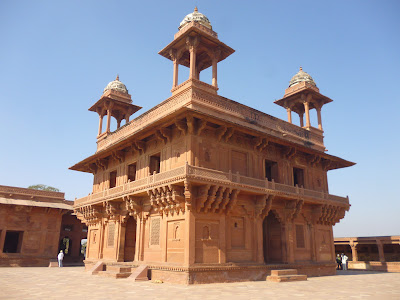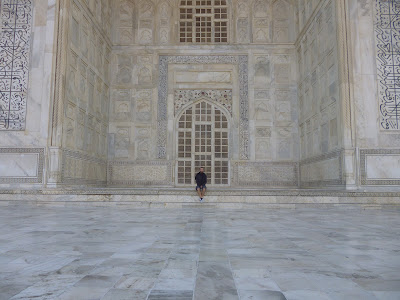Cuando estábamos en los Sunderbans Álvaro le preguntó a
Martin, uno de los austriacos con los que coincidimos (y vegetariano), que cómo
de fácil o de difícil le resultaba comer en los diferentes países por los que
viajaba. De su respuesta, entre otras cosas, retuvimos esto: “aunque no he
encontrado ningún lugar en el que fuera imposible, la India es el único país en
el que he estado hasta ahora donde los platos vegetarianos son los principales
en el menú”.
Y antes de que la gente empiece a echar pestes sobre el
vegetarianismo, una puntualización. Muchas personas son vegetarianas no porque
piensen que comer carne es malo en sí, sino porque están en contra de la
crueldad hacia los animales.
Me explico: el problema no es que se mate a una vaca, sino
que la vaca que nos comemos tiene unas condiciones de vida y muerte muy poco
dignas. En la industria cárnica no se respetan muchas veces los derechos de los
animales. Son hacinados, maltratados, cebados con hormonas y medicamentos, y
finalmente asesinados. Los huevos de gallina y los pollos que nos comemos no
viven alegremente en granjas. Las gallinas están encerradas en naves
industriales en las que nunca se apaga la luz (para que piensen que es de día y
sigan poniendo huevos) y los pollos alimentados con hormonas para que crezcan
antes y antibióticos para que no enfermen.
El problema no es la carne, sino qué carne. Muchas personas,
tras considerar de dónde viene lo que comen, han optado por consumir productos
bio y/o abandonar la carne.
Una vez dicho esto, os comentamos qué y cómo se come en la
India. Como decía Martin, en el menú reina de forma masiva la opción vegetariana.
De hecho, muchos restaurantes son vegetarianos, y los productos en los
supermercados tienen un punto verde cuando son vegetarianos y otro rojo cuando
no lo son.
Aunque al principio se nos hacía raro, en seguida nos adaptamos muy bien a la falta de
carne/pescado en el menú. Como no entendíamos los nombres de los platos, pedíamos
casi siempre a boleo, y nunca quedamos insatifech@s. En la India cocinan tan
bien y con tanto arte que un@ puede olvidar la carne para siempre.
Otra peculiaridad de la cocina india, que puede ser o no
vegetariana, son los llamados thalis.
Se trata de una bandeja con distintos compartimentos en los que te sirven una
variedad de platos de los que puedes repetir todas las veces que quieras. Un thali típico tiene arroz, un curry de verduras, pan, dhal (a base de lentejas), una ensalada, y algún otro
guiso con patatas o judías verdes, y de postre
yogur o requesón.
Pero no vamos a negar, a pesar del amor que existe en la
India por la comida vegetariana, que también cocinan con carne, y lo hacen muy
bien. Para l@s carnívoros, sabed que hay una variedad casi infinita de carnes
con salsas y a la brasa, guisadas con salsa de yogur, hierbas y verduras que harán
vuestras delicias.
Si lo que os gusta es comer, la India es vuestro destino,
pero recordad: ¡L@s vegetarian@s primero!
When we
were in the Sunderbans Álvaro asked Martin, one of the Austrians we met there
(and a vegetarian), how hard or easy for him was to eat in the different
countries he was traveling to. After his answer we kept this in mind: “even if
it is never impossible, India is the only country I’ve been where the
vegetarian dishes come first in the menu”.
And before
people start pestering about vegetarianism, a clarification. A lot of people are
vegetarian not because they think that eating meat is bad by itself, but
because they are against the cruelty against animals.
The thing
is: the problem isn’t to kill a cow, but that the cow we eat has a life and
dead conditions without dignity. Most of the time in the meat industry animal’s
rights are not respected. They are stacked, mistreated, feed with hormones and
drugs, and finally slaughtered. The hens’ eggs and the chickens we eat don’t
live merrily in farms. The hens are locked up in warehouses where they never
turn the lights off (so the hens think it’s always daytime and keep laying
eggs) and the chickens are fed with hormones so they grow faster and with antibiotics
to prevent them from getting sick.
The problem
isn’t the meat, but what kind of meat. A lot of people, after considering where
their food comes from, have decided to consume bio products and/or abandon meat.
After
leaving this clear, we let you know what and how people eat in India. As Martin
said, the vegetarian option rules massively the menus. In fact, a lot of
restaurants are vegetarians, and the products in the supermarkets have a green
dot when they are veg, and a red one when they aren’t.
Although it
was weird for us at the beginning, we rapidly adapted to the lack of meat/fish
in the menu. Because we didn’t understand the names of the dishes, we generally
ordered randomly, and were never disappointed. In India they cook so well that
you could forget meat forever.
Another feature
of the Indian cuisine, which can be or not vegetarian, are the so-called thalis. It consists of a tray with
different compartments where you get a variety of dishes that can be refilled
as many times as you want. A standard thali comes with rice, a vegetables curry, bread, dhal (made out of lentils),
a salad, and another stew with potatoes or green beans, and curd or sweet
cheese for dessert.
But we are
not going to deny that, despite the love Indians profess for the veg cuisine, they
also cook with meat, and are very good at it. For meat lovers, we want to let
you know that there is an almost never ending variety of meat dishes with gravy
or roasted, stewed with yoghurt sauce, herbs and vegetables that will delight
you.
If you like
eating, India is your destination, but remember: Vegs come first!




















































